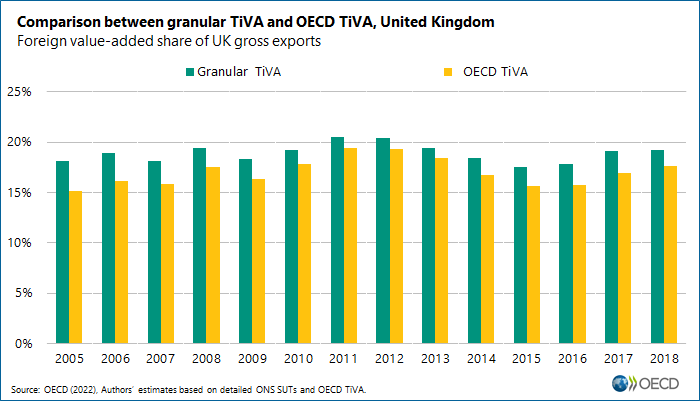International trade and balance of payments statistics
New approaches to compute TiVA indicators for the United Kingdom
May 2022 - The COVID-19 crisis has raised questions about supply-chains resilience and where to draw the line between dependency on foreign products given national security concerns and the benefits that integration into global value chains (GVCs) provides. This calls for a better understanding of how production is organised through domestic integration (i.e. suppliers are domestic firms) or international integration (i.e. the suppliers are abroad).
Trade in value added (TiVA) addresses the limitations of conventional trade data by considering the value added by each country in the production of goods and services that are consumed worldwide. TiVA indicators can be measured from either an international or a national perspective. The international perspective has been adopted by various international organisations and research institutions which have mapped out the global production network by integrating many countries’ Supply and Use Tables (SUTs – which show production linkages within countries) with trade statistics (which show exchanges between countries). TiVA indicators derived under the international perspective thus account for the distribution of value added across the entire GVCs capturing all direct and indirect effects. By its very nature, the international approach is data intensive and requires a series of adjustments and estimates to set up comprehensive and consistent accounts for global trade and production.
Alternatively, TiVA indicators can be derived using only information available at a national level. The advantage is to rely on information that is often richer, providing more detail on inter-industry flows and their links with imports and exports. Another advantage is that this approach does not require data adjustments nor strong assumptions to derive a set of relevant TiVA indicators. But this also means that the analysis cannot capture trade inter-dependencies in an international setting, for example how dependent UK exporters and consumers are on intermediate and final products supplied by individual foreign countries.
This report examines UK engagement in GVCs from a national perspective, with the objective of complementing existing indicators of trade integration. It departs from previous work in three main ways:
-
Firstly, it provides a more granular picture of UK supply chains by leveraging data from detailed SUTs covering 105 industries/products, published by the Office for National Statistics (ONS), for the period 2005-2018.
-
Secondly, the work adopts a ‘consumer approach’, thereby extending the analysis beyond the traditional producer approach as follows: the value that is added by distribution sectors (wholesale or resale activity) is added to the production chain of a particular sector, giving rise to a valuation as seen by the final purchaser (Ahmad, 2019). This consumer approach thus complements the traditional, producer-based measures of TiVA.
-
Thirdly, it adds to the timeliness of TiVA indicators based on the national approach with estimates for 2019 by exploiting quarterly and annual National Accounts data.
The analysis undertaken in this report suggests that TiVA indicators based on granular and consumer approaches are promising complementary sources of information to OECD TiVA indicators. Differences between the alternative approaches are generally small at an aggregate level. However significant differences exist in a few industries, warranting further investigation, for instance by extending the scope of the analysis to other countries, data permitting.

Download the report
|
Contact
For further information contact the OECD Statistics and Data Directorate.
Related Documents
